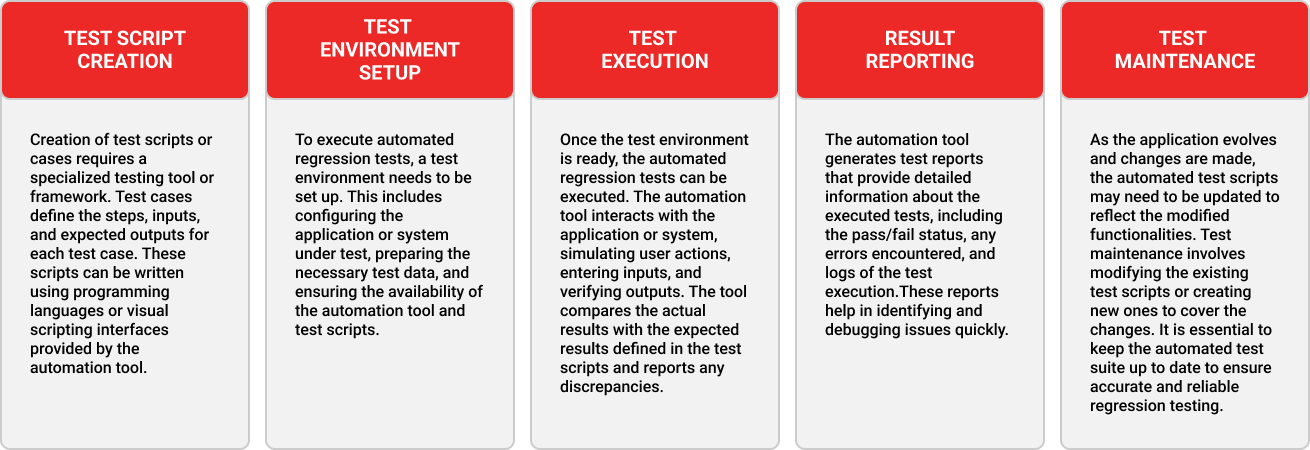In the digitally evolving world, most companies are looking for solutions that can reduce their time to market, while boosting the quality of their products or services. In-house IT teams and testing professionals are thus challenged to continuously test, keep the changes updated, and prompt the changes in the operation cycle.
While in reality, there isn’t a single part of the software that can be made 100% bug free, benefits of automation regression testing ensures a continuous re-tests of the portion of software after the last update or upgrade to ensure its functionality isn’t changed negatively. Regression testing is aimed at catching any bug that might have unknowingly made its way into the updated section of the software.
Manual Regression Testing
The manual regression testing process refers to the practice of manually executing a set of test cases to ensure that a software application or system functions correctly after modifications or updates have been made.
Manual Regression Testing Challenges
| Time and Effort | This type of testing requires testers to execute, compare test cases and identify them to bugs. With the evolving software and systems, there is a need for keeping test scripts up-to-date. This demands an alignment of test scripts with the changes made. The entire process is quite repetitive, tedious and requires significant effort. |
| Human Error | Manual regression testing is prone to errors and overlooking the bugs or executing test scripts inaccurately can lead to disastrous results. |
| Limited Test Coverage | With manual regression testing, the volume of test cases is extensive. This can lead to limited test coverage, leaving potential gaps in testing. |
| Maintenance | Maintenance of this test suite is a resource-intensive process. This is especially true when the application goes through upgrades or updates. |
| Scalability & Repetition | It is challenging to scale for complex software systems which might result in a tedious effort for each regression cycle. |
Manual Regression Testing Costs
| Time & Resources | Requires a team allocation which ties up the resources, increases labor cost. Moreover, organizations might also need to invest in upskilling the testers to ensure they have the updated knowledge and skills. |
| Delayed Time to Market | The more test cases that require manual regression testing, will delay the release of updates, bug fixes, and release of new features. This potentially impacts project timeline and time-to-market. |
| Increased Costs | Hiring, training testers and other efforts that manual regression testing demands leads to increased costs for organizations. |
| Quality Issues | Manual regression testing is susceptible to human error. It leaves the application with undetected issues, resulting in poor software quality and customer dissatisfaction. |
| Maintenance Costs | Maintaining the test suites require both efforts and resources which contribute to increased maintenance costs. |
While manual regression testing has its challenges and costs, organizations often combine it with the benefits of automated regression testing to mitigate some of these issues and improve overall efficiency and effectiveness.
Leveraging the benefits of automated regression testing can help reduce resource requirements, accelerate testing cycles, and improve overall efficiency. By automating repetitive and time-consuming tasks, organizations can allocate resources more effectively, enhance release timelines, and mitigate escalating expenses associated with manual testing.
Automated Regression Testing
Business-critical system is significantly improved by lowering manual efforts and raising the level of automation for regression testing. Such a beneficial effect is evident in large-scale business software systems where manual regression testing is challenging, time-consuming, and labor-intensive due to the abundance of potential test scenarios. Automation enables firms to minimize such difficulties and produce better models.
Automated Regression Testing Framework

Automated Regression Testing Benefits
Resource Allocation
Saving resources could be the primary consideration when harnessing the benefits of automated regression testing for a project. The extra time saved can be used for establishing procedures, implementing new processes, and correcting issues. Hence, there will be less mistakes, which means the client will get a top-notch product.
Obtaining Feedback Quickly
Getting instantaneous data is one of the obvious benefits of regression test automation. Automation enables an iterative process where tasks are completed concurrently in order to analyze findings and correct earlier processes. This not only saves time, but also enables instant access to the correct information and error correction.
24-Hour Operation
Continuous test execution is made possible through automation at any hour of the day. With a timetable, it is unnecessary to constantly be there and manually conduct tests every day or every week. But when you leverage the benefits of automated regression testing, this can be done in the background or at a time that is convenient for you, including late at night.
Scalability
One of the most important benefits of automated regression testing is its continuous procedure. The manual method cannot match with automation in terms of speed and frequency. This implies that operations can be scaled and quality control improved even without expensive resources.
Streamlining Maintenance
A product develops a lot of new functions, so it needs to be tested frequently. The number of test cases continues to grow with time. Eventually, manually maintaining the test scripts becomes challenging. Transparency offered by automated regression testing makes it possible to configure tests without affecting the code. This makes the servicing procedures simpler and quicker.
Improved Situational Awareness
This technique boosts analytics’ potential, particularly when tests fail. This method gives the testers a better understanding of the product’s condition. They are therefore more likely to identify the issue and identify its root causes. This accelerates decision-making to remove flaws and improves decision accuracy.
In order to create a robust and efficient testing framework that ensures quality and performance, we recommend starting by identifying the challenges, business needs, and opportunities of improvement.

